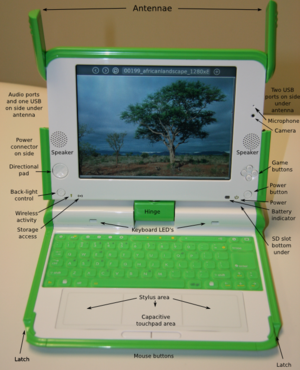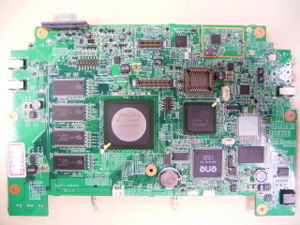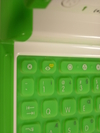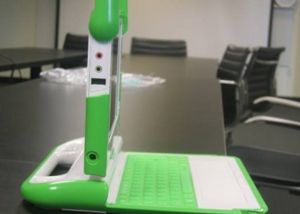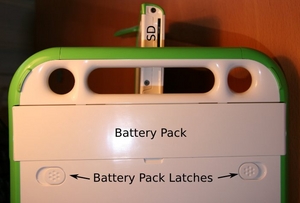Hardware specification
Hardware details for OLPC, November 30, 2006
Maintained from a document written by Michael Bove by Jim Gettys.
First Generation System
BTest-1 Systems
Approximately 875 systems were built by Quanta and are being distributed. These are fully functional machines, but built before the rigorous testing that will now take place. Much more information about the BTest-1 systems can be found in the BTest-1 Release Notes. Some of the details of the hardware design are to support the OLPC Human Interface Guidelines.
Specifications
Physical dimensions:
- Dimensions: 193mm × 229mm × 64mm (as of 3/27/06—subject to change)
- Weight: Less than 1.5 KG (target only—subject to change)
- Configuration: Convertible laptop with pivoting, reversible display; dirt- and moisture-resistant system enclosure
Core electronics:
- CPU: AMD Geode GX-500@1.0W(datasheet)
- CPU clock speed: 366 Mhz
- Compatibility: X86/X87-compatible
- Chipset: AMD CS5536 South Bridge (datasheet)
- Graphics controller: Integrated with Geode CPU; unified memory architecture
- Embedded controller (for production), ENE KB3700: File:KB3700-ds-01.pdf
- DRAM memory: 128 MiB dynamic RAM
- Data rate: Dual – DDR266 – 133 Mhz
- BIOS: 1024KB SPI-interface flash ROM; LinuxBIOS open-source BIOS; Open Firmware bootloader
- Mass storage: 512 MiB SLC NAND flash, high speed flash controller
- Drives: No rotating media
Display:
- Liquid-crystal display: 7.5” Dual-mode TFT display
- Viewing area: 152.4 mm × 114.3 mm
- Resolution: 1200 (H) × 900 (V) resolution (200 dpi)
- Mono display: High-resolution, reflective monochrome mode
- Color display: Standard-resolution, quincunx-sampled, transmissive color mode
- Special "DCON" chip, that enables deswizzling and anti-aliasing in color mode, while enabling the display to remain live with the processor suspended. Since we will always be running the frame buffer at 1200x900 resolution, the color resolution is lower, but exactly how this works out in effective resolution is very complex. Mary Lou Jepsen is planning to write document to explain the effective resolution, which is higher than if we simply reduced the size of the frame buffer and used the red, green and blue channels. Easiest, and most convincing, may be to measure it with appropriate test patterns; in the meanwhile, you can examine this photograph of the display (it looks even nicer in person; photographing a display is remarkably difficult).
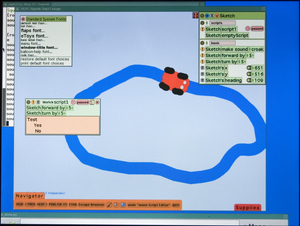 eToys (Squeak) running on the OLPC display
eToys (Squeak) running on the OLPC display
Integrated peripherals:
- Keyboard: 70+ keys, 1.2mm stroke; sealed rubber-membrane key-switch assembly
- Keyboard Layouts
- Layout pictures - US International, Thai, Arabic, Spanish, Portuguese, Nigeria
- Cursor-control keys: five-key cursor-control pad; four directional keys plus Enter
- Touchpad: Dual capacitance/resistive touchpad; supports written-input mode
- Audio: Analog Devices AD1888, AC97-compatible audio codec; stereo, with dual internal speakers; monophonic, with internal microphone and using the Analog Devices SSM2211 for audio amplification
- Wireless: Marvell Libertas 88W8388+88W8015, 802.11b/g compatible; dual adjustable, rotating coaxial antennas; supports diversity reception
- Status indicators: Power, battery, WiFi; visible lid open or closed
- Video camera: 640x480 resolution, 30FPS
External connectors:
- Power: 2-pin DC-input, 10 to 25 V, -23 to -10 V
- Line output: Standard 3.5mm 3-pin switched stereo audio jack
- Microphone: Standard 3.5mm 2-pin switched mono microphone jack; selectable sensor-input mode
- Expansion: 3 Type-A USB-2.0 connectors; SD Card slot
- Maximum power: 500 mA (total)
Battery:
- Pack type: 5 Cells, 6V series configuration
- Fully-enclosed “hard” case; user removable
- Capacity: 22.8 Watt-hours
- Cell type: NiMH
- Pack protection: Integrated pack-type identification
- Integrated thermal sensor
- Integrated polyfuse current limiter
- Cycle life: Minimum 2,000 charge/discharge cycles (to 50% capacity of new, IIRC).
- Power Management will be critical
BIOS/loader:
- LinuxBIOS is our BIOS for production units; Open Firmware is used as the bootloader.
Environmental specifications:
- Temperature: somewhere in between typical laptop requirements and Mil spec; exact values have not been settled
- Humidity: Similar attitude to temperature. When closed, the unit should seal well enough that children walking to and from school need not fear rainstorms or dust.
- Altitude: -15m to 3048m (14.7 to 10.1 psia) (operating), -15m to 12192m (14.7 to 4.4 psia) (non-operating
- Shock: 125g, 2ms, half-sine (operating) 200g, 2ms, half-sine (non-operating)
- Random vibration: 0.75g zero-to-peak, 10Hz to 500Hz, 0.25 oct/min sweep rate (operating); 1.5g zero-to-peak, 10Hz to 500Hz, 0.5 oct/min sweep rate (nonoperating)
- 2mm plastic walls (1.3mm is typical for most systems).
Regulatory requirements:
- The usual US and EU EMI/EMC requirements will be met.
- The laptop and all OLPC-supplied accessories will be fully UL and is RoHS compliant.
What makes this system unique?
See Hardware uniqueness.
Photographs of ATest Prototype Electronics
Power up of the first OLPC electronics prototype boards occurred April 15, 2006. Power and ground testing continued over the weekend, and formal debug and BIOS bring up started Monday, April 17, 2006 at Quanta Computer's labs in Taipei, Taiwan. By Wednesday, April 19, Linux was booting on the first generation prototypes.
- Component side OLPC circuit board
- Back side of the OLPC circuit board
- Picture of Linux running with circuit board in the lab
- Picture of the screen of Linux running on the OLPC circuit board; fittingly, it shows a Chinese desktop
B-Test
A small number of pre-BTest boards were built in preparation for building complete BTest systems. Developer information about B-test boards are here.
Later BTest Systems
Several more builds of beta systems are planned for after the turn of the year.
Hardware Design Process
Designing hardware is much more constrained than software; while you may sometimes have great influence on the design of a chip many months in advance of availablility, you can only actually use chips which you can get in the volumes required at prices that you can afford. Even a single missing component, or component not available in the quantities you need, may cripple your production. Many in the software community, who are used to more fluid ability to modify design and produce in unlimited copies, find this a foreign concept.
Designing hardware is similar to making sausage: you may be able to grow new ingredients starting long in advance if you are friendly with farmers (chip designers). You can only make your sausage, however, with the ingredients required by your recipe that you can actually buy in the volume you need to manufacture. Sometimes you can substitute ingredients without spoiling the general recipe, and sometimes the result would be inedible. In this case, we have a single chip that Mark Foster is specifying, that sits between the CPU and the display, and over which we have detailed control.
If you'd like some insight into this process, you can look at older versions of this page in the wiki.
High-Volume Design and Manufacturing
Furthermore, production of high-volume hardware is now a very specialized business, and is now often joint between the organization/company that specifies what the hardware should do—often to the point of selection of major and minor components—and an ODM (original device manufacturer), which specializes in very high-volume design and production. The ODM generally does the detailed design for production; e.g., exact part selection if there are variants, schematics, layout, board routing, mechanical design, testing, debugging for production, logistics, and production of the finished goods.
In OLPC's case, the ODM is Quanta, as announced in mid December. There is a good chance that your laptop was manufactured by Quanta, headed by Barry Lam, which is possibly the largest company few people have heard of. Quanta manufactures more laptops than any other company in the world (almost 1/3rd of the total made), whether branded HP or Apple or others. Detailed design of the first production OLPC design is just starting, though OLPC has investigated (and continues to investigate) the possible components and other design tradeoffs.
Note that CPU chip manufacturers generally provide sample designs, development boards, and application notes, that are often complete and usable by themselves, though often include interfaces or hardware you might not choose in volume production. These clarify how their products might be "designed in" to actual products. Our prototype machine seen at Tunis was using one of the AMD "Rumba" boards. It approximated much of the first OLPC hardware, though used a conventional disk rather than NAND flash, and has components we will not use (e.g. ethernet), and that conceptual (but working) model lacked the much cheaper flat panel that is under development.
Detailed schematics and layouts of such sample AMD designs are generally available in the chip manufacturer's developer programs. If you are interested in exact design details of hardware you can get for immediate experimentation, we direct your attention to these programs, which generally include the ability to buy such sample hardware. Most of the information required to program devices, however, is completely freely available at the manufacturer's web sites in fully public specifications.
In concert with ODMs, such sample designs are generally customized to fit the exact product needs and engineered for high-volume-production tooling and techniques that are not applicable to low-volume development-board runs. OLPC has just entered in partnership with Quanta on this engineering-for-production phase of the project .
Detailed schematics and board layouts of these high-volume designs are often considered proprietary to the ODM's, or jointly owned by both parties involved. They represent the competitive advantage one ODM may have with its rivals (who may have access to the same components as they do). Those design schematics are sometimes available to programmers after production starts under NDA agreements; for example, schematics of many of the iPAQ handhelds were made available to programmers in the open-source community under NDA, when insufficient written programming information was available. OLPC will try to document our designs sufficiently to avoid NDAs; we expect this will be less effort than the logistics of requiring NDAs in such a large and diverse community.
Foreseeable Designs
Currently we can foresee three generations of machines: a first one to ship in mid 2007.
Subsequent OLPC designs may use components that have not yet been shipped by their manufacturer, and we often will arrange a program whereby the open source community can get early access to specifications of those components for driver development.
We also can anticipate future display technologies such as E-Ink, though such displays are still cloudy in the crystal ball.
We will try to keep this specification up to date as more and more details of the first design (and subsequent designs) are nailed down, provide links to specifications for the chosen components, and provide information required to program them (e.g. address space assignments).
The first generation design uses already available components, with the (major) exception of the new flat panel and the chip that drives it, and we expect a novel bi-modal touch pad, and a ASIC to interface NAND flash, SD and a camera.
The electrical interface to the flat panel and the LCD panel itself is now in detailed engineering. A family of flat panels all based on a common LCD panel, but differing on their use of color filters, what kinds of backlights or temporal color, which have different properties (power consumption, resolution, gamut) and risks will be built in the future, the initial display panel uses color filters and works extremely well, and does not require TFT process changes for manufacturing.
Several other designs are higher risk, but better performance, either on effective resolution or power consumption. It we will initially use this low risk panel and may phase in one of the alternatives to manufacturing later in 2007 or 2008. 3M is building specialized plastic optical components being used in the design of these displays.
